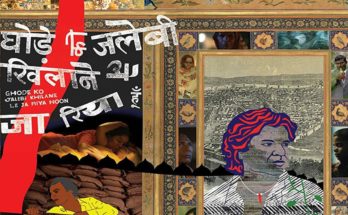Rumours of Spring by Farah Bashir, pp- 248. Publisher- Fourth Estate India. ISBN-10: 9354897843. Paperback (price)- Rs-314
Farah Bashir’s Rumours of Spring is a haunting tale of girlhood in distress. The apricity had died in the hope of rumoured spring. The book describes the eerie silence in the valley that caught a young heart. The shadow of cold winter draped into bullets became a torrent of horrors since then. What happens to a girl when she meets her real self under the tree of abnormal life surrounded by guns?
Bashir’s story mirrors the saga of scars that Kashmir has suffered. The unravelling became a personal account of everyday crises offering a strong political statement and binaries. Bashir’s own life became her testimony of the chilling reality of 90’s Kashmir. The valley never came out from the noise of bullets. Bashir’s fascinating portrayal of life under abnormal everydayness is a story of the dying hope of a young girl waiting for the new dawn that could save her soul thundered under the siege of violence. This intersection of the personal and political blurred in narrating the life of girlhood journeying in distress.

The book poignantly makes the first-hand account of a girl and how life embraces her amidst violence and turmoil. Bashir’s memoir opens with her bobeh’s (grandmother’s) funeral interspersed with flashbacks from her adolescent years when the ghost of conflict was looming in Kashmir. The memoir as it runs deeper straddles into clouds and shadows of bobeh’s funeral Evening, Night, Early Hours, Dawn, Morning and Afterlife. Each chapter sketches out facets of Bashir’s life, marked by curfew, shootings, kidnappings, massacres and extreme surveillance. Bashir’s writing is disturbingly emotional navigating her ordeals as a young girl in the valley of hopeless warmth.
Farah Bashir’s memoir is about girlhood in Kashmir and her search for the self from a gendered lens. The lens that could see the violence from above and within. Bashir’s honest and simple writing touches the reader’s heart, making her story emotionally appealing. Bashir truthfully describes the anxieties of women living close to the troops. The incident of Kunan Poshpora- a painful reminder of the violence in Kashmir. Bashir remembers the fear of walking alone on roads, getting caught in a crossfire, and more.
What’s shocking and disappointing is that more than half a century has passed, but the reality of ordinary Kashmiris has been a living horror under the crossfire between militants and military control and for girls, the horror runs deep into the inferno.
The omnipresence of death reminds the readers how violence is normalised as an everyday reality for Kashmiris. The fact that the memoir opens with the author’s family preparing for their bobeh’s funeral reminds the reader that death defines the only thread finding its place in every chapter of the book. Simple existence is fraught with danger in Kashmir. Exchanging letters going to work, owning a business, and getting an education, nothing is easy for the Kashmiris as they are constantly walking on eggshells. Their existence is considered a threat, as a consequence of which their life becomes a series of deadly episodes where survival is a dangerous task. The effects of the violence are evident in the mannerisms of the characters in the memoir. The protagonist tries to hide by looking “unattractive”. She tries very hard not to fit the conventional beauty standards so as to not attract any unwanted attention to herself.
Also Read
‘The Afghanistan Papers: a Secret History of the War’ by Craig Whitlock
Scared by the explosions, she becomes depressed and develops anxiety. To cope, she starts to aggressively scratch her head and pull-out strands of her hair. She is terribly afraid of the dark and refuses to leave her room even when she has to use the washroom. The author is diagnosed with Post Traumatic Stress Disorder (PTSD) or more popularly known as Perennially Traumatic Stress Disorder amongst the protagonist’s friends. Through Farah’s brilliant lens the reader is shaken by the arbitrariness of violence when the protagonist narrates an incident when her old neighbour became a victim of a stray bullet and died on spot. Innocent people get caught up in the politics of war and are tagged as “criminals” without the simple need for evidence.
Bashir humanises the violence by giving the readers her accounts of her friends and family who had to naviage the insidious, apathetic culture of violence under the totalitarian rule of troops in Kashmir valley. But within these shocking moments of violence and trauma, are little pockets of warmth where the protagonists try to find little joy for themselves in order to make life bearable. It is here that we see the 90’s culture is reflected. The author’s memories and flashbacks make the readers time-travel into the past and some moments of the unreal world when she steals her father’s tape recorder and listens to Pakistani and Bollywood pop songs. Her agony of finding herself, the sweet pain of first love and its ensuing loss.
Through Bashir’s writing, readers informed themselves an intimate and candid portrayal of Kashmir, its life and culture. The writing is colloquial, mixed with local Kashmiri phrases and words, which makes the narrative inordinately exuberantly and powerfully authentic. Bashir’s story is remarkable because we get a deeply personal view of our own living history. A lot has been written about Kashmir, but ‘Rumors of Spring’ is special for its refreshing take on the gendered nature of violence.
Bashir diminishes the binaries of the personal and the political- the public and the private in this searing tale of girlhood in Kashmir. If anyone cares to feel the agony of a conflict and its horror then Farah Bashir’s Rumors of Spring is a compelling read for anyone looking to unfurl the pages of the bloody history of Kashmir. The Girlhood in Kashmir and that long for spring narrates how violence is normalised and the only reality left are rumours.

The reviewer Aiman Masoodi is currently pursuing her master’s from Nelson Mandela Centre for Peace & Conflict Resolution, Jamia Millia Islamia, New Delhi. She did her Bachelors in Economics and Political Science from St. Stephen’s College, New Delhi. Her academic interest lies in conflict analysis and international relations. She can be reached at masoodiaiman200@gmail.com




